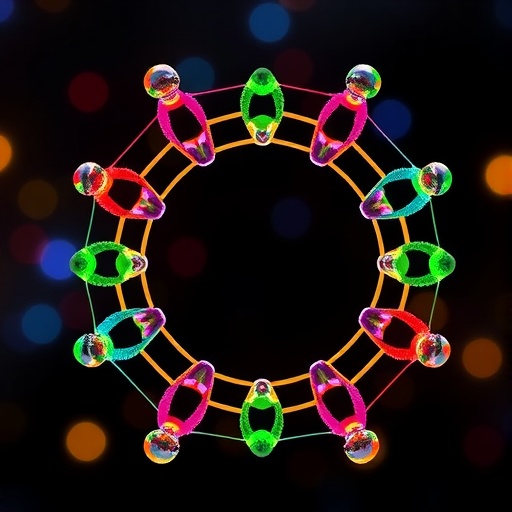In the rapidly evolving field of supramolecular chemistry, the design and synthesis of sophisticated chiral nanostructures have garnered considerable interest due to their potential applications in nanotechnology and materials science. Among these, cyclic topological nanostructures such as toroids and Möbius strips represent fascinating targets, offering unique physical and optical properties derived from their intricate chiral architectures. Despite their significance, the controlled assembly of macrocyclic molecules into well-defined chiral toroidal or Möbius strip topologies has remained an exceptional and challenging feat, often limited by the complexities of molecular design and self-assembly dynamics.
A breakthrough advancement has been reported in the journal National Science Review, where researchers have successfully engineered a class of chiral amphiphilic pillar[5]arene derivatives. These derivatives are functionalized by covalently attaching enantiomerically pure glutamide units to the macrocyclic framework. This clever molecular design exploits the intrinsic chirality of glutamide moieties to propagate well-ordered chiral supramolecular interactions within the assemblies. By employing strategic self-assembly techniques, including the anti-solvent method, the researchers maneuvered these chiral macrocycles to spontaneously organize into highly ordered toroidal topologies at the nanoscale, pushing the frontier in topological nanoarchitecture synthesis.
The assembled structures were subjected to rigorous analysis under varying solvent compositions, primarily focusing on tetrahydrofuran (THF)/water mixtures. It was observed that the nature and evolution of the supramolecular assemblies are profoundly solvent-dependent. At low water content, the amphiphilic pillar[5]arenes formed stable bilayer vesicular structures, characteristic of traditional amphiphile assemblies driven predominantly by hydrophobic interactions and hydrogen bonding networks. However, as the water concentration was elevated to 70%, the system underwent remarkable morphological transformations, transitioning from vesicles to chiral toroidal nanostructures. Most intriguingly, some of these toroids dynamically reconfigured into unique Möbius strip-like nanorings, exhibiting twisted topologies that bear non-trivial knot characteristics.
These topological nanostructures arise from an intricate interplay of non-covalent forces governing the self-assembly process. Hydrogen bonding interactions between glutamide side chains establish directional and stereospecific intermolecular contacts, promoting regular stacking and chiral ordering. Complementing this, van der Waals forces stabilize the assembled framework by facilitating close packing of aromatic units within the macrocycle cores. Additionally, π-π stacking interactions between the aromatic rings inherent to pillar[5]arene scaffolds contribute to the overall structural integrity, enhancing the formation of well-defined nanoscale patterns with chiral topology. The combined synergy of these forces enables not only the emergence of toroidal morphologies but also the thermodynamically less-favored Möbius strip configurations through subtle entropic and enthalpic adjustments mediated by solvent environment.
Beyond structural achievements, these chiral toroidal assemblies exhibit remarkable optoelectronic properties that distinguish them from other supramolecular aggregates. Specifically, only the toroidal forms manifest strong blue circularly polarized luminescence (CPL), an optical phenomenon that arises from the differential emission of left- or right-handed circularly polarized light due to molecular chirality. The chirality and defined topology inherently impart dissymmetry in electronic transitions, resulting in CPL activity with potentially high luminescence dissymmetry factors. Contrastingly, vesicular or amorphous aggregated states fail to exhibit such CPL, highlighting the pivotal role of controlled topology in governing chiroptical behaviors.
An additional dimension of functional versatility emerges from the capacity of these chiral toroids to act as supramolecular templates for the induction of circularly polarized luminescence in otherwise achiral guest dyes. Traditionally, achieving CPL from achiral luminophores is elusive due to lack of intrinsic asymmetry. However, the researchers demonstrated that by encapsulating or associating achiral fluorescent molecules, either blue or red-emitting dyes, within the chiral toroidal framework, these dye molecules could be coerced into emitting CPL signals. This supramolecular chirality transfer effect is unprecedented in the context of topological nanoassemblies and opens avenues for designing novel CPL-active materials with customizable emission wavelengths through co-assembly approaches.
The methodology undertaken to create these chiral topologies artfully integrates molecular design, precise tuning of solvent mixtures, and advanced characterization techniques. The anti-solvent method facilitated kinetic control over the assembly pathways, allowing researchers to access metastable intermediates that evolve into thermodynamically favored toroidal and Möbius structures. Atomic force microscopy (AFM) provided direct nanoscale imaging to confirm the presence and morphology of toroidal topologies at approximately 70% water content in THF/water systems, offering definitive visualization of these complex assemblies for the first time.
These findings mark a paradigm shift in the engineering of hierarchical chiral architectures from macrocyclic building blocks, bridging the molecular scale with nanoscale structural precision. The ability to manipulate chirality and topology simultaneously not only enriches fundamental understanding of supramolecular chemistry but also enables practical manipulation of chiroptical phenomena, which are invaluable for developing advanced materials in photonics, sensing, and chiral optoelectronics. The dynamic reconfiguration observed between vesicles, toroids, and Möbius strips further illustrates the tunable nature of such systems, hinting at potential applications in responsive or adaptive nanomaterials.
Moreover, the solvent-driven topological evolution highlights the crucial role of solvent environment as a regulatory parameter for self-assembly outcomes. This controlled structural modulation underscores the importance of intermolecular interaction balance, providing a versatile platform where chiral topologies with varying degrees of complexity and function can be selectively generated. The work encourages future exploration into multi-component systems and external stimuli-responsive protocols to expand the diversity and functionality of chiral nanoarchitectures.
In conclusion, the research establishes an innovative strategy for the bottom-up construction of chiral toroidal and Möbius nanostructures rooted in carefully crafted macrocyclic molecules. The demonstrated capacity to precisely control chiral topology and corresponding luminescent properties through solvent-mediated assembly provides a blueprint for the rational design of next-generation chiral nanomaterials. These advances promise to impact fields ranging from asymmetric catalysis to chiral photonic devices, where control over topology and chirality at the nanoscale dictates functional performance. As the understanding of topological supramolecular chemistry deepens, this work serves as a landmark contribution propelling the synthesis of multidisciplinary functional materials.
Subject of Research: Supramolecular assembly of chiral macrocyclic molecules into toroidal and Möbius strip nanostructures
Article Title: (Not explicitly provided in the content)
Web References:
https://doi.org/10.1093/nsr/nwaf280
Image Credits: Jie Lu
Keywords: supramolecular chemistry, chiral assemblies, toroidal nanostructures, Möbius strips, pillar[5]arene derivatives, circularly polarized luminescence, solvent-mediated self-assembly, glutamide functionalization, π-π stacking, hydrogen bonding, nanorings, chiroptical properties




